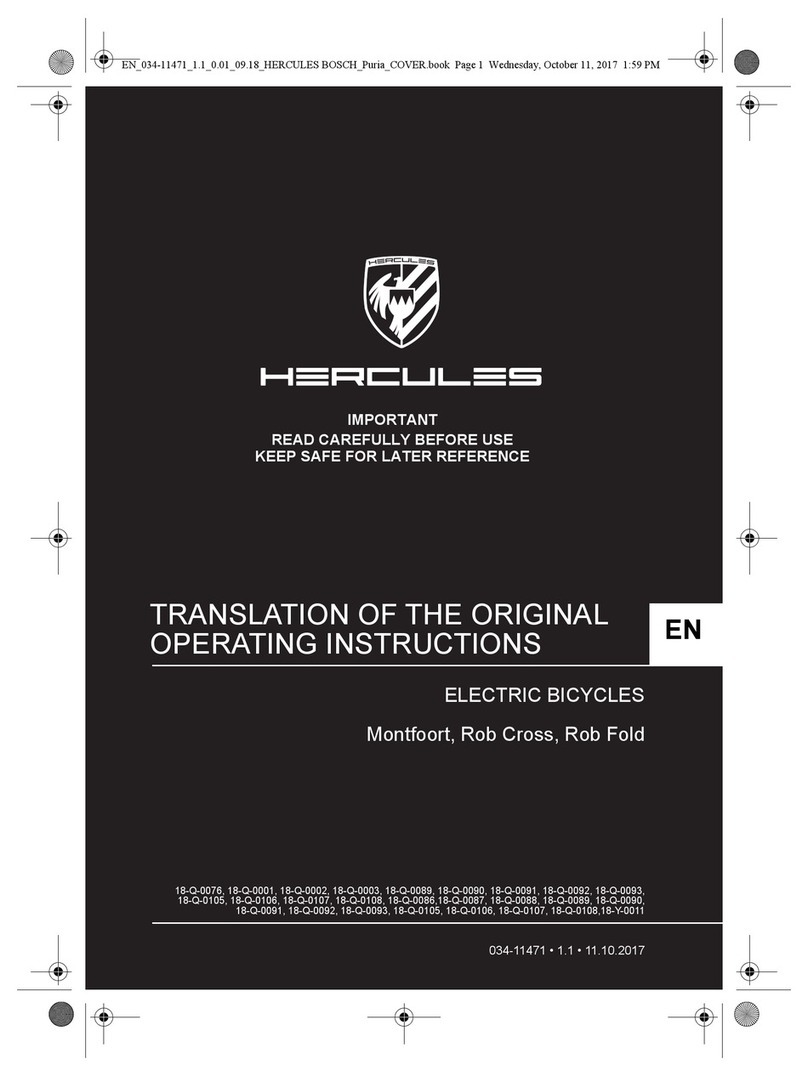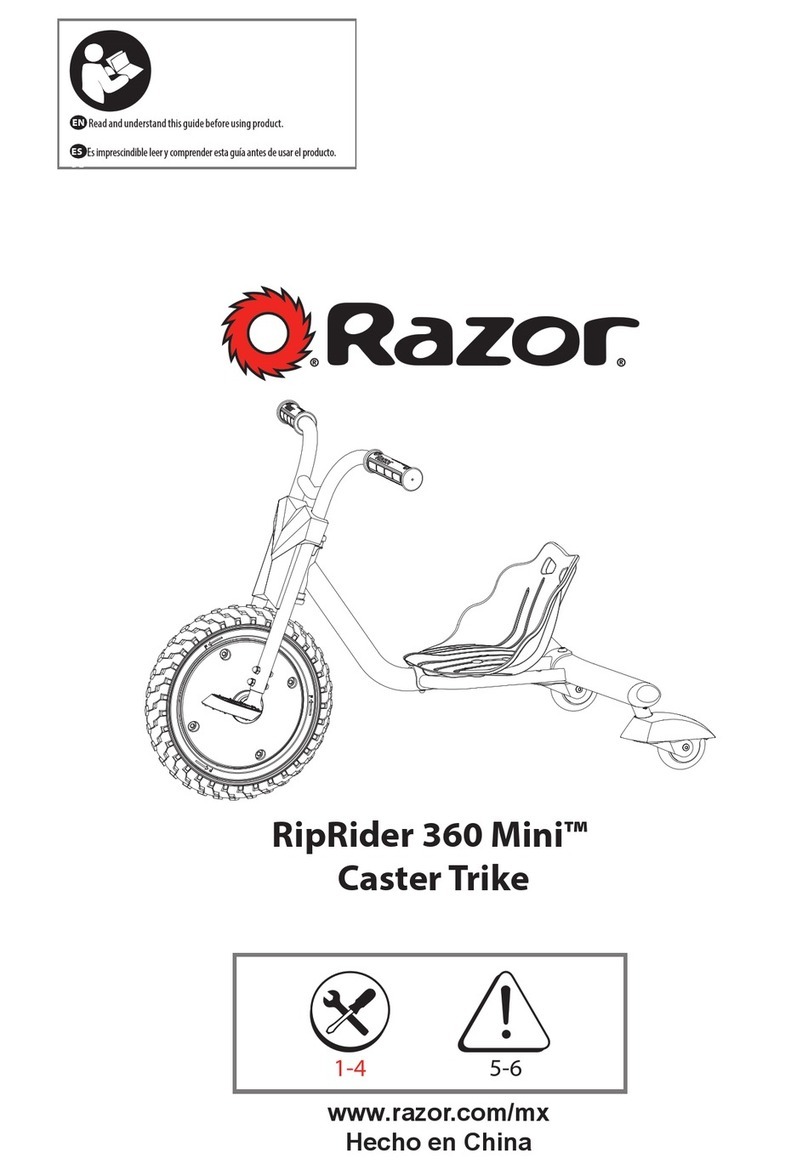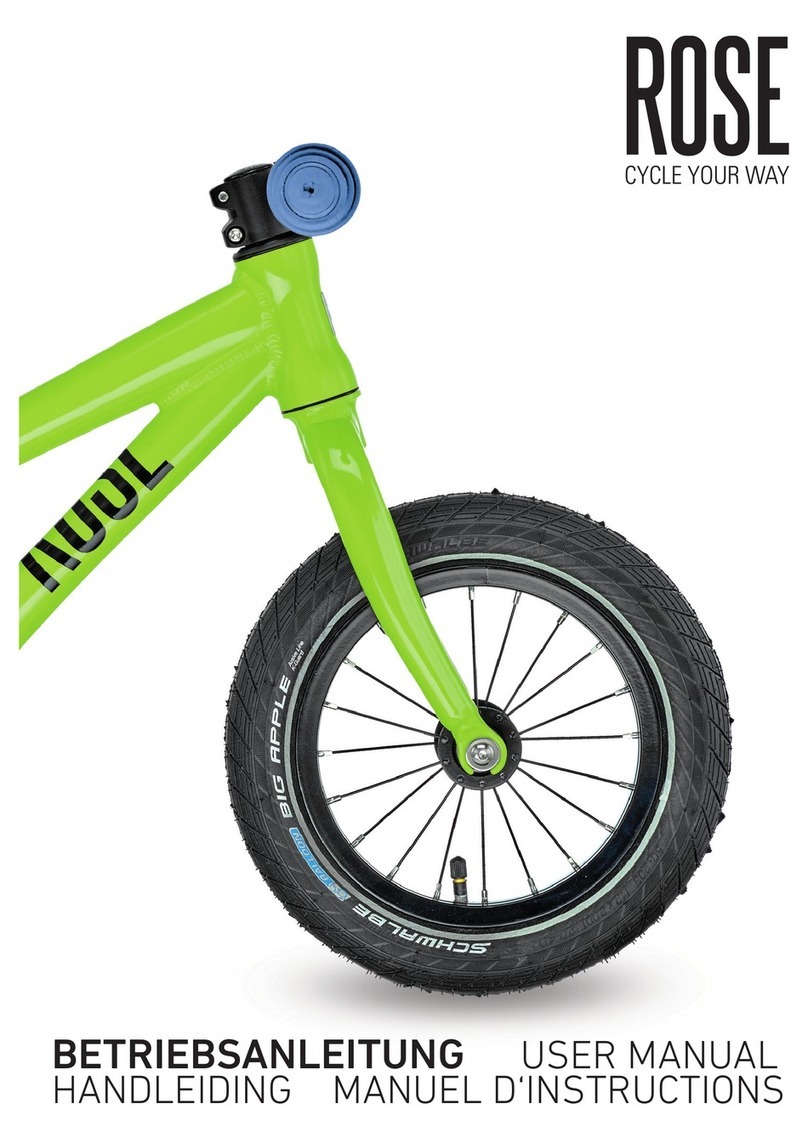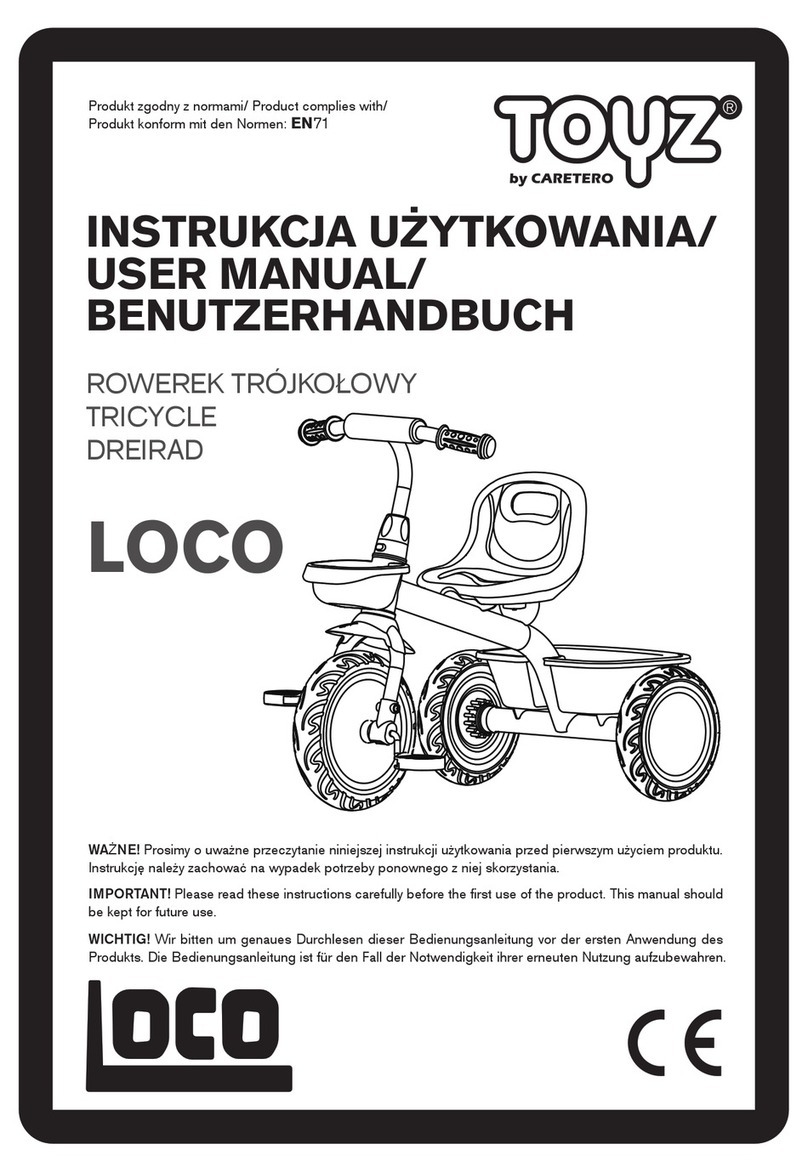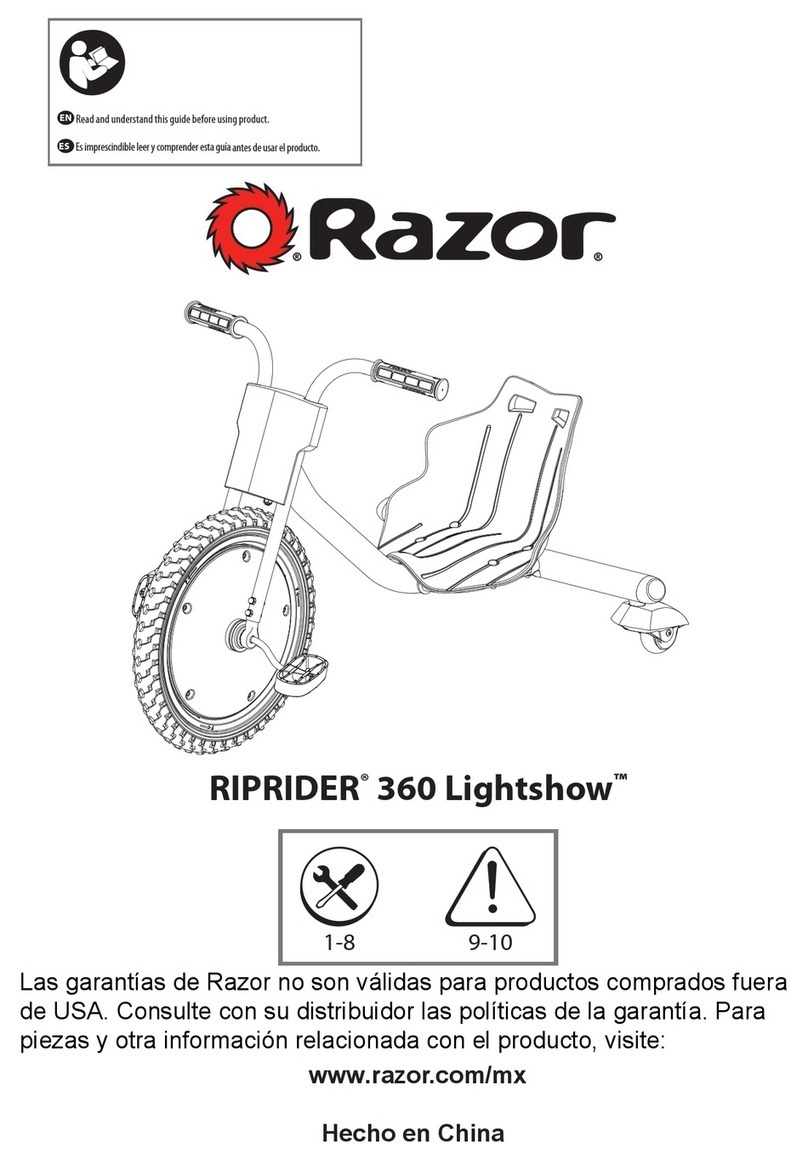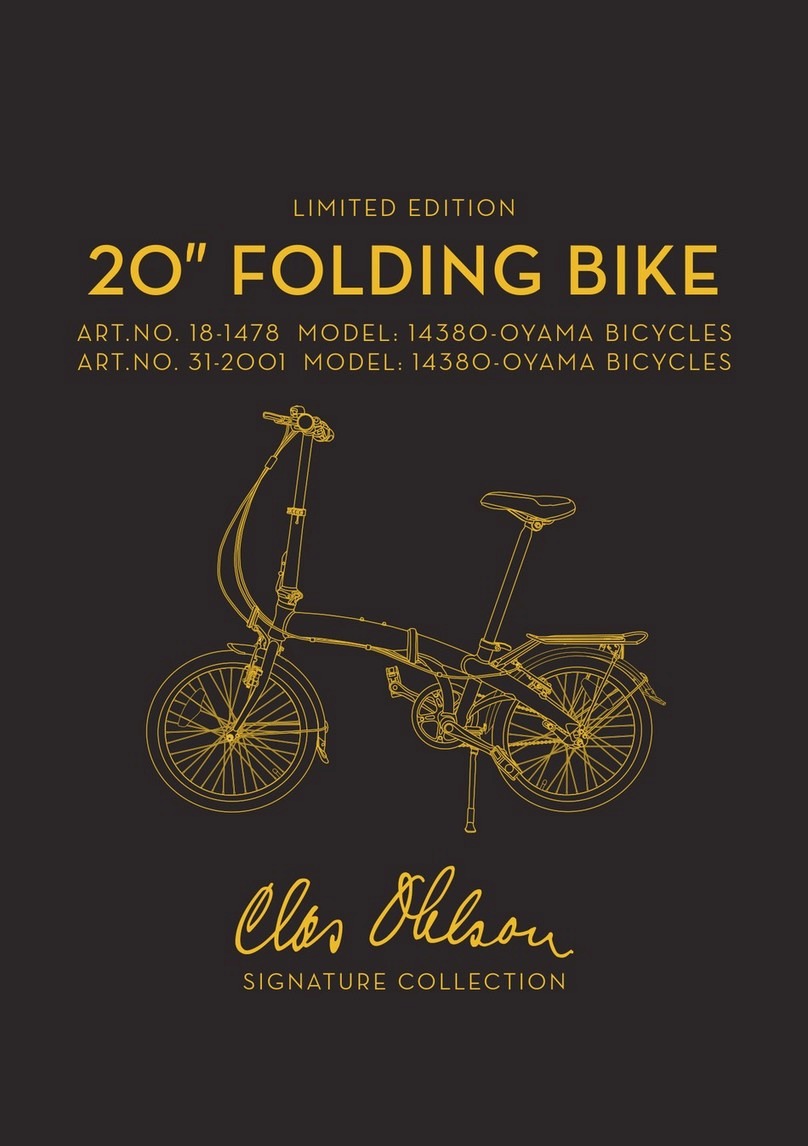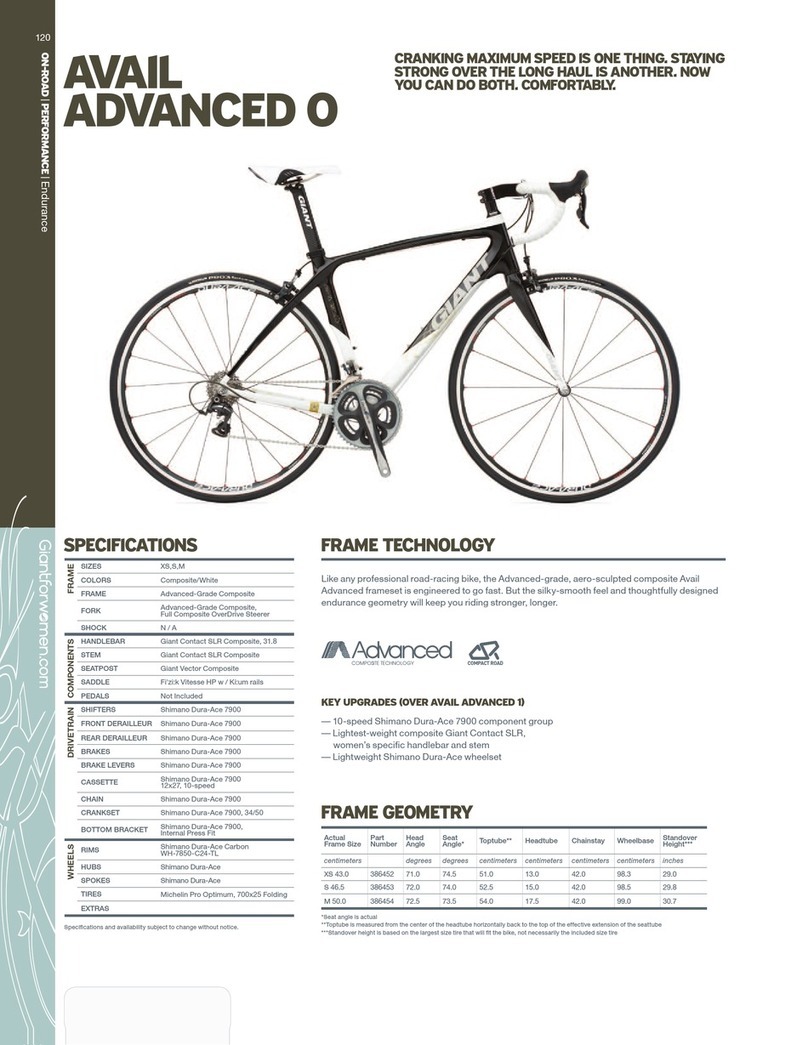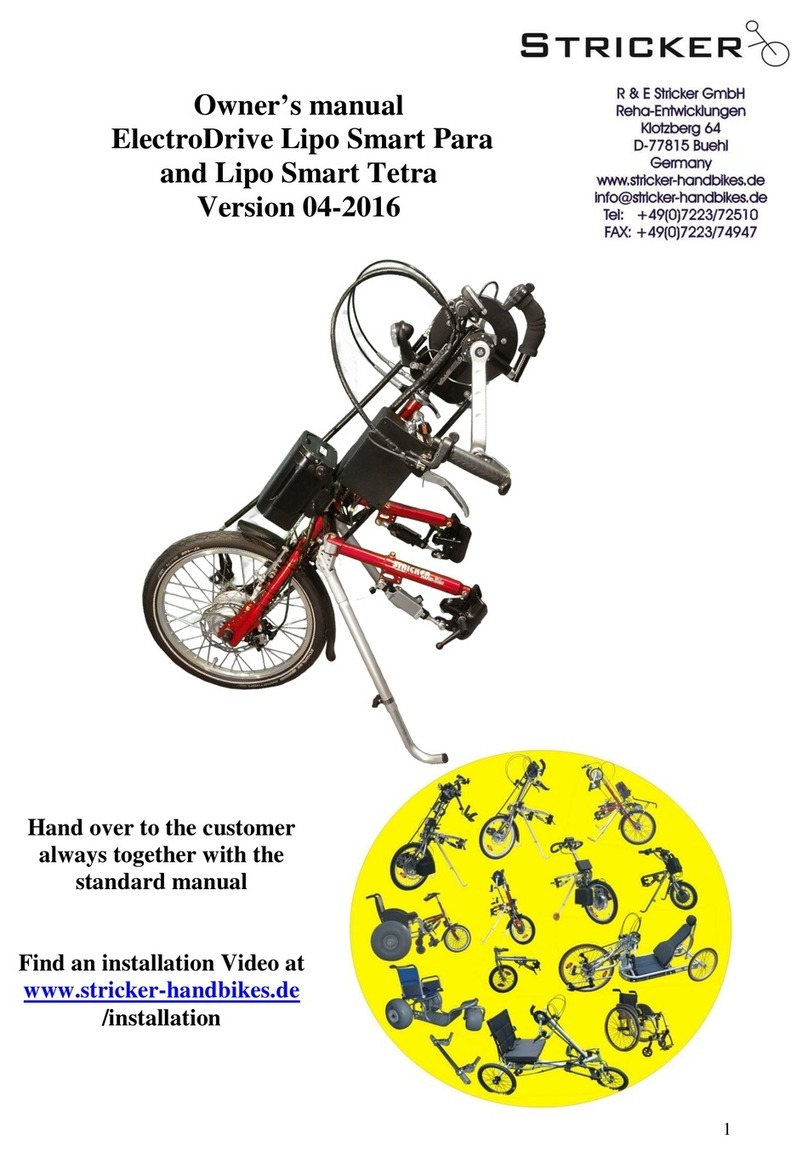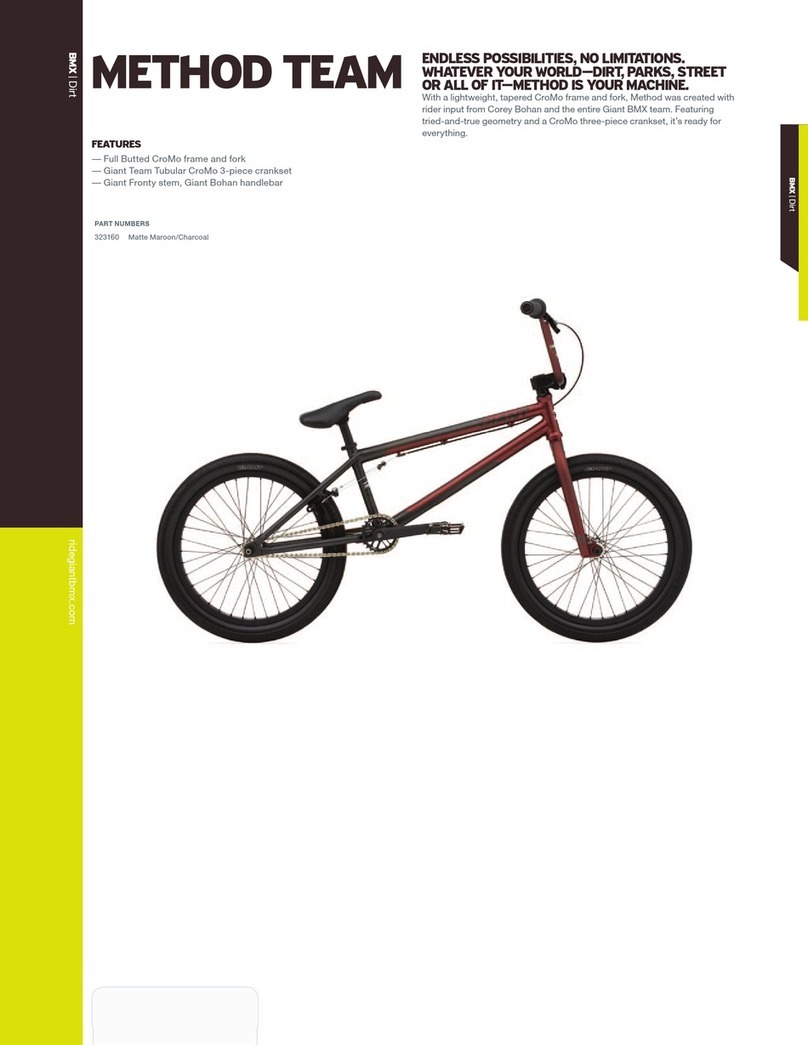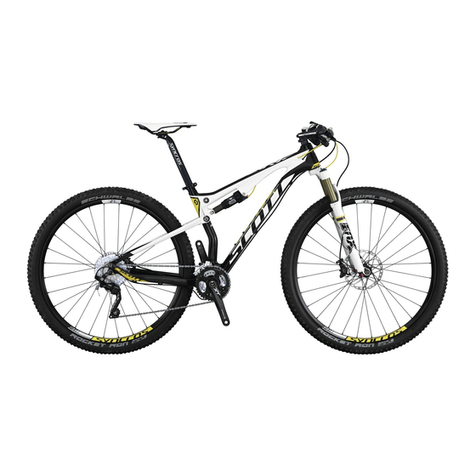Hercules PASERO COMP I-12 Quick guide

TRANSLATION OF THE ORIGINAL OPERATING INSTRUCTIONS
IMPORTANT
READ CAREFULLY BEFORE USE
KEEP SAFE TO CONSULT AT A LATER DATE
Operating instructions for HERCULES BROSE Topology MY21
PASERO COMP I-12, PASERO COMP I-F5, PASERO PRO I-12, PASERO SPORT I-10, PASERO SUV I-10
21-Q-0023, 21-Q-0024, 21-Q-0025, 21-Q-0026, 21-Q-0027, 21-Q-0028, 21-Q-0029, 21-Q-0030, 21-Q-0031, 21-Q-0032, 21-Q-0033, 21-Q-0079, 21-Q-0080
MY21H02 - 12 • 1.0 • 19. October 2020
1

MY21H02 - 12_1.0_19.10.2020 2
Contents
Contents
1 About these operating instructions 6
1.1 Manufacturer 6
1.2 Language 6
1.3 Laws, standards and directives 6
1.4 For your information 6
1.4.1 Warnings 6
1.4.2 Markups 7
1.5 Nameplate 8
1.6 Type number and model 9
1.7 Identifying the operating instructions 9
2 Safety 10
2.1 Residual risks 10
2.1.1 Risk of fire and explosion 10
2.1.1.1 Rechargeable battery 10
2.1.1.2 Overheated charger 10
2.1.1.3 Hot components 10
2.1.2 Electric shock 10
2.1.2.1 Damage 10
2.1.2.2 Water penetration 10
2.1.2.3 Bridging 10
2.1.3 Risk of a crash 11
2.1.3.1 Incorrect quick release setting 11
2.1.3.2 Incorrect tightening torque 11
2.1.4 Risk of amputation 11
2.1.5 Key breaking off 11
2.2 Toxic substances 11
2.2.1 Brake fluid 11
2.2.2 Suspension oil 11
2.2.3 Defective battery 11
2.3 Requirements for the rider 11
2.4 Vulnerable groups 11
2.5 Personal protective equipment 12
2.6 Safety markings and safety instructions 12
2.7 What to do in an emergency 12
2.7.1 Dangerous situation in road traffic 12
2.7.2 Leaked brake fluid 12
2.7.3 Battery vapours emitted 13
2.7.4 Battery fire 13
2.7.5 Leaked brake fluid 13
2.7.6 Oil and lubricant leaks from the fork 13
2.7.7 Oil and lubricant leaks from the rear
frame damper 13
3Overview 14
3.1 Description 15
3.1.1 Wheel 15
3.1.1.1 Valve 15
3.1.2 Suspension 15
3.1.2.1 Rigid fork 15
3.1.2.2 Suspension fork 15
3.1.2.3 Steel suspension fork 17
3.1.2.4 Air suspension fork 17
3.1.3 Brake system 18
3.1.3.1 Disc brake 18
3.1.4 Electric drive system 19
3.1.4.1 Motor 19
3.1.4.2 Rechargeable battery 19
3.1.5 On-board computer 20
3.1.5.1 Operating element 20
3.2 Proper use 21
3.3 Improper use 22
3.3.1 Maximum permitted total weight 23
3.4 Technical data 24
3.4.1 Pedelec 24
3.4.2 Brose Drive S motor 24
3.4.3 Brose Drive T motor 24
3.4.4 Brose Topology on-board computer 24
3.4.5 SuperCore 750 battery 24
3.4.6 SuperCore 555 battery 25
3.4.7 Emissions 25
3.4.8 Tightening torque 25
3.5 Description of controls and screens 26
3.5.1 Handlebars 26
3.5.2 On-board computer 26
3.5.2.1 <Home screen> 26
3.5.2.2 <Set screen> 27
3.5.2.3 Daytime and night mode 28
3.5.2.4 System message 28
3.5.3 Battery level indicator (rechargeable
battery) 28
3.6 Environmental requirements 29
4 Transportation and storing 31
4.1 Physical transport characteristics 31
4.2 Designated handles/lifting points 31
4.3 Transportation 32
4.3.1 Using the brake transport securing
system 32
4.3.2 Transporting the pedelec 32
4.3.3 Shipping a pedelec 32
4.3.4 Transporting the battery 32
4.3.5 Shipping the battery 32
4.4 Storing 33
4.4.1 Storage mode 33
4.4.1.1 Activating 33
4.4.1.2 Deactivating 33
4.4.2 Break in operation 33
4.4.2.1 Preparing a break in operation 33
4.4.2.2 Carrying out a break in operation 33
5 Assembly 34
5.1 Required tools 34
5.2 Unpacking 34
5.2.1 Scope of delivery 34

MY21H02 - 12_1.0_19.10.2020 3
Contents
5.3 Commissioning 34
5.4 Preparing the battery 35
5.4.1 Checking the battery 35
5.4.2 Retrofitting the battery locking lever 35
5.4.2.1 Preparing the frame 35
5.4.2.2 Fitting the locking lever 36
5.4.3 Installing the wheel in the Suntour fork 36
5.4.4 Checking the stem and handlebars 37
5.4.4.1 Checking the connections 37
5.4.4.2 Firm hold 37
5.4.4.3 Checking the headset backlash 37
5.5 Pedelec sale 37
6 Operation 38
6.1 Risks and hazards 38
6.2 Personal protective equipment 39
6.3 Tips for a greater range 40
6.4 Error messages 41
6.4.1 Error message display 41
6.5 Instruction and customer service 43
6.6 Adjusting the pedelec 43
6.6.1 Adjusting the saddle 43
6.6.1.1 Adjusting the saddle tilt 43
6.6.1.2 Determining the seat height 43
6.6.1.3 Adjusting the seat height with quick
release 44
6.6.1.4 Adjusting the seat position 44
6.6.2 Adjusting the handlebars 45
6.6.3 Adjusting the stem 45
6.6.3.1 Adjusting the height of the handlebars 45
6.6.3.2 Adjusting the quick release clamping
force 45
6.6.4 Adjusting the brake 45
6.6.4.1 Retracting the brake linings 46
6.6.5 Adjusting the damping sag 46
6.6.5.1 Adjusting the Suntour fork steel
suspension 46
6.6.5.2 Adjusting the Suntour fork air
suspension 47
6.6.6 Adjusting the rebound damping 48
6.6.6.1 Adjusting the Suntour air suspension
fork 49
6.7 Accessories 50
6.7.1 Child seat 50
6.7.2 Trailer 51
6.7.2.1 Trailer approval for Enviolo hub gear 51
6.7.3 Pannier rack 52
6.7.4 Mobile holder 52
6.7.5 Suspension fork coil spring 52
6.7.6 Tubeless and airless 52
6.8 Check list before each ride 53
6.9 Raising the kickstand 54
6.10 Using the pannier rack 54
6.11 Using the saddle 54
6.12 Rechargeable battery 55
6.12.1 Removing the battery 55
6.12.2 Inserting the battery 55
6.12.3 Charging the battery 56
6.12.4 Waking the battery 56
6.13 Electric drive system 57
6.13.1 Switching on the electric drive system 57
6.13.2 Switching off the drive system 57
6.14 On-board computer 58
6.14.1 Switching the on-board computer on 58
6.14.2 Switching off the on-board computer 58
6.14.3 Using the riding light 58
6.14.4 Using the push assist system 59
6.14.5 Selecting the level of assistance 59
6.14.6 Switching the journey information 60
6.14.7 Changing the system information 60
6.14.7.1 Setting background colour 60
6.14.7.2 Setting units 61
6.14.7.3 Adjusts the backlight 61
6.14.7.4 Setting the clock 61
6.14.7.5 Switching the PIN prompt on and off 62
6.14.7.6 Changing the PIN 62
6.14.7.7 Resetting the settings 63
6.15 Brake 64
6.15.1 Using the brake lever 64
6.16 Suspension and damping 65
6.16.1 Suspension fork compression adjuster 65
6.16.1.1 Adjusting the Suntour compression
adjuster 66
6.17 Gear shift 67
6.17.1 Using the derailleur gears 67
6.18 Parking the pedelec 68
7 Cleaning and servicing 69
7.1 Cleaning after each ride 69
7.1.1 Cleaning the suspension fork 69
7.1.2 Cleaning the rear frame damper 69
7.1.3 Cleaning the pedals 69
7.2 Basic cleaning 70
7.2.1 Cleaning the frame 70
7.2.2 Cleaning the stem 70
7.2.3 Cleaning the wheel 70
7.2.4 Cleaning the drive elements 70
7.2.5 Cleaning the rear frame damper 70
7.2.6 Cleaning the chain 71
7.2.7 Cleaning the battery 71
7.2.8 Cleaning the on-board computer 71
7.2.9 Cleaning the motor 71
7.2.10 Cleaning the brake 72
7.3 Servicing 72
7.3.1 Servicing the frame 72
7.3.2 Servicing the stem 72
7.3.3 Servicing the fork 72

MY21H02 - 12_1.0_19.10.2020 4
Contents
7.3.4 Servicing the drive elements 72
7.3.5 Servicing the pedals 72
7.3.6 Servicing the chain 72
7.4 Maintenance 73
7.4.1 Wheel 73
7.4.1.1 Checking the tyres 73
7.4.1.2 Checking the rims 73
7.4.1.3 Checking and adjusting the tyre
pressure – Dunlop valve 73
7.4.1.4 Checking and adjusting the tyre
pressure – Presta valve 74
7.4.1.5 Checking and adjusting the tyre
pressure – Schrader valve 74
7.4.2 Brake system 74
7.4.3 Checking the brake linings for wear 74
7.4.4 Checking the pressure point 74
7.4.5 Checking the brake discs for wear 74
7.4.6 Checking the electrical cables and
brake cables 75
7.4.7 Checking the gear shift 75
7.4.8 Checking the stem 75
7.4.9 Checking the belt and chain tension 75
8 Maintenance 76
8.1 Suspension system 77
8.1.1 Rear frame damper 77
8.1.2 Suspension fork 78
8.1.3 Suspension seat post 79
8.2 Axle with quick release 79
8.2.1 Checking the quick release 80
8.3 Maintaining the stem 80
8.4 Adjusting the gear shift 80
8.4.1 Cable-operated gear shift,
single-cable 80
8.4.2 Cable-operated gear shift,
dual-cable 81
8.4.3 Cable-operated twist grip,
dual-cable 81
9 Troubleshooting, fault clearance
and repair 82
9.1 Troubleshooting and fault clearance 82
9.1.1 The drive system or display do not
start up 82
9.1.2 Error message 82
9.1.3 Assistance function errors 83
9.1.4 Battery error 84
9.1.5 Display errors 85
9.1.6 Lighting does not work 85
9.1.7 Other errors 86
9.1.8 Suspension fork 87
9.1.8.1 Rebound too fast 87
9.1.8.2 Rebounding too slowly 88
9.1.8.3 Suspension too soft on inclines 89
9.1.8.4 Excessively hard damping on bumps 90
9.2 Repair 91
9.2.1 Original parts and lubricants 91
9.2.2 Replacing the lighting 91
9.2.3 Adjusting the headlight 91
9.2.4 Tyre clearance check 91
10 Recycling and disposal 92
11 Documents 93
11.1 Parts list 93
11.1.1 PASERO PRO I-12 93
11.1.2 PASERO COMP I-12 94
11.1.3 PASERO COMP I-F5 95
11.1.4 PASERO SPORT I-10 96
11.1.5 PASERO SUV I-10 97
11.2 Assembly report 98
11.3 Maintenance instructions 100
11.4 SuperCore drilling template 104
12 Glossary 105
12.1 Abbreviations 107
12.2 Simplified terms 107
13 Appendix 108
I. Translation of the original EC/EU
Declaration of Conformity 108
14 Keyword index 109

MY21H02 - 12_1.0_19.10.2020 5
About these operating instructions
Thank you for your trust!
HERCULES pedelecs are premium quality
bicycles. You have made an excellent choice.
Your specialist dealer will provide you with
guidance and instruction and assemble your
product. Your specialist dealer will also be happy
to assist you in the future whether you require
maintenance, conversion or repair.
You are receiving these operating instructions
with your new pedelec. Please take time to
become familiar with your new pedelec and follow
the tips and suggestions in the operating
instructions. They will help you to enjoy your
pedelec for a long time to come. We hope you
have fun and wish you well on all of your rides!
These operating instructions are mainly designed
for the rider or the operator. They aim to ensure
that non-professionals can use the pedelec safely.
Download the operating
instructions onto your
phone at the following link,
so that you can use them
when you are out riding:
https://www.hercules-bikes.de/de/de/index/
downloads.html.
Copyright
© HERCULES GmbH
Distribution or reproduction of these operating
instructions and utilisation or communication of
their content is prohibited unless expressly
approved. Any infringement will render the
offender liable for compensation. All rights
reserved in the event that a patent, utility model or
industrial design is registered.
Editing
Text and images:
ZEG Zweirad-Einkaufs-Genossenschaft eG
Longericher Straße 2
50739 Köln, Germany
Translation
RKT Übersetzungs- und Dokumentations-GmbH
Markenstrasse 7
40227 Düsseldorf, Germany
In case of any questions or problems
regarding these operating instructions,
please contact:
tecdoc@hercules-bike.de
Notice
These operating instructions are not a substitute
for personal instruction by the supplying specialist
dealer.
These operating instructions are an integral part
of the pedelec. Therefore, if it is re-sold at a later
time, they must be handed over to the subsequent
owner.
Sections are also designed especially for the
specialist dealer. These sections aim to ensure
that specialist dealers complete initial assembly
and maintenance safely and reliably. The
sections for specialist dealers are highlighted in
grey and marked with a spanner symbol.

MY21H02 - 12_1.0_19.10.2020 6
About these operating instructions
1 About these operating
instructions
1.1 Manufacturer
The pedelec manufacturer is:
HERCULES GMBH
Longericher Straße 2
50739 Köln, Germany
Tel.: +49 4471 18735 0
Fax: +49 4471 18735 29
E-mail: [email protected]
Website: www.hercules-bikes.de
Subject to internal changes
The information contained in these operating
instructions are the approved technical
specifications at the time of printing. Any
significant changes are included in a new
published version of the operating instructions.
You will find any modifications to these operating
instructions at:
https://www.hercules-bikes.de/de/de/index/
downloads.htm
1.2 Language
The original operating instructions are written in
German. A translation is invalid without the
original operating instructions.
1.3 Laws, standards and directives
The operating instructions comply with the
essential requirements specified in:
• Machinery Directive 2006/42/EC
• Electromagnetic Compatibility Directive
2014/30/EU
• ISO 20607:2018 Safety of machinery –
Instruction handbook – General drafting
principles
• EN 15194:2018 Cycles – Electrically power
assisted cycles – pedelec bicycles
• EN 11243:2016, Cycles – Pannier racks for
bicycles – Requirements and test methods
• ISO 17100:2016-05 Translation Services –
Requirements for translation services.
1.4 For your information
Different markings are used in the operating
instructions to make them easier to read.
1.4.1 Warnings
Warnings indicate hazardous situations and
actions. You will find warnings in the operating
instructions:
Will lead to serious or even fatal injuries if
ignored. High-risk hazard.
May lead to serious or even fatal injuries if
ignored. Medium-risk hazard.
May lead to minor or moderate injuries if ignored.
Low-risk hazard.
Notice
May lead to material damage if ignored.
DANGER
!
WARNING
!
CAUTION
!

MY21H02 - 12_1.0_19.10.2020 7
About these operating instructions
1.4.2 Markups
You will find stylised forms of typeface in the
operating instructions:
Instructions for specialist dealers are highlighted
in grey. They are indicated by a screwdriver
symbol. Information for specialist dealers does
not require non-professionals to take any action.
Stylised form Use
Italics Glossary term
Underlined in blue Link
Underlined in grey Cross references
Check marks Requirements
Triangle Instruction for action
1Instruction for
action
Several instructions for
action in specified order
Result of the action
SPACED Indicators on the display
screen
• Bulleted lists
Only applies to pedelecs
with this equipment Each type has a different
kind of equipment. A
note beneath the
heading indicates
components which can
be used as an
alternative.
Table 1: Markups

MY21H02 - 12_1.0_19.10.2020 8
About these operating instructions
1.5 Nameplate
The nameplate is situated on the frame. You can
see the exact position of the nameplate in Figure 2.
You will find thirteen pieces of information on the
nameplate.
Figure 1: Example Nameplate
Typ:
21-17-1017
0,25 kW / 25 km/h
zGG 150 kg
EPAC 25 kg
BJ 2020 / MJ 2021
EN 15194
nach
EPAC
2
3
1
4
5
6
7
89
12
13
10
11
Hercules GmbH
Longericher Str. 2
50739 Köln, Germany
No. Designation Description
1CEmarking The manufacturer uses the CE marking to declare that the pedelec complies with
applicable requirements.
2 Manufacturer's contact details You can contact the manufacturer at the address. You can find more information in
Section 1.
3 Type number All pedelec models have an eight-digit type number, which is used to specify the design
model year, the type of pedelec and the version. You can find more information in
Section 1.
4 Maximum continuous power The maximum continuous power is the greatest possible power for the electric motor
output shaft over 30 minutes.
5 Maximum permitted total weight The maximum permitted total weight is the weight of the fully assembled pedelec with the
rider and baggage.
6 Year of manufacture The year of manufacture is the year in which the pedelec was manufactured. The
production period is from August 2020 to July 2021.
7 Pedelec type You can find more information in Section 3.2.
8 Safety markings You can find more information in Section 1.4.
9 Disposal instructions You can find more information in Section 10.
10 Area of use You can find more information in Section 3.6.
11 Model year The model year refers to the first production year that the series-manufactured pedelec
was produced in the version concerned. The year of manufacture is different to the model
year in some cases.
12 Weight of the ready-to-ride pedelec The weight of the ready-to-ride pedelec is specified as a weight of 25 kg or above and
refers to its weight at the time of purchase. You must add each additional accessory to
the weight.
13 Shut-off speed The speed that the pedelec reaches at the moment when the current has dropped to zero
or to the no-load current value.
Table 2: Nameplate details

MY21H02 - 12_1.0_19.10.2020 9
About these operating instructions
1.6 Type number and model
These operating instructions are an integral part
of pedelecs with the type numbers:
1.7 Identifying the operating
instructions
The Identification number position is located on
bottom left-hand side on each page. The
identification number is composed of the
document number, the version number and the
release date.
Type no. Model Pedelec type
21-Q-0023 PASERO PRO I-12
(Diamant) City and trekking
bicycle
21-Q-0024 PASERO PRO I-12
(Trapez) City and trekking
bicycle
21-Q-0025 PASERO PRO I-12
(central tube) City and trekking
bicycle
21-Q-0026 PASERO COMP I-12
(Diamant) City and trekking
bicycle
21-Q-0027 PASERO COMP I-12
(Trapez) City and trekking
bicycle
21-Q-0028 PASERO COMP I-12
(central tube) City and trekking
bicycle
21-Q-0029 PASERO COMP I-F5
(Diamant) City and trekking
bicycle
21-Q-0030 PASERO COMP I-F5
(central tube) City and trekking
bicycle
21-Q-0031 PASERO SPORT I-10
(Diamant) City and trekking
bicycle
21-Q-0032 PASERO SPORT I-10
(Trapez) City and trekking
bicycle
21-Q-0033 PASERO SPORT I-10
(central tube) City and trekking
bicycle
21-Q-0079 PASERO SUV I-10
(Diamant) City and trekking
bicycle
21-Q-0080 PASERO SUV I-10
(central tube) City and trekking
bicycle
Table 3: Type number, model and pedelec type
Identification number MY21H02 - 12_1.0_19.10.2020

MY21H02 - 12_1.0_19.10.2020 10
Safety
2 Safety
2.1 Residual risks
2.1.1 Risk of fire and explosion
2.1.1.1 Rechargeable battery
The safety electronics may fail if the batteries are
damaged or faulty. The residual voltage can
cause a short circuit. The battery may self-ignite
and explode.
Only use and charge the battery and
accessories if they are in perfect condition.
Never open or repair the battery.
Batteries with external damage must be
removed from service immediately.
If a battery is dropped or struck, remove it from
service and observe it for at least 24 hours.
Faulty batteries are hazardous goods. Dispose
of faulty batteries in the correct manner. Store
battery in a dry place until disposal. Never
store in the vicinity of flammable substances.
The battery is only protected from spray water.
Penetration by water can cause a short circuit.
The battery may self-ignite and explode.
Never immerse the battery in water.
Put battery out of service if you suspect water
has penetrated it.
Temperatures over 60 °C can also cause liquid to
leak from the battery and the battery will become
damaged. The battery may self-ignite and
explode.
Protect the battery against heat.
Never store next to hot objects.
Never expose the battery to sustained direct
sunlight.
Avoid wide temperature fluctuations.
Chargers with excessive voltage damage
batteries. This may result in fire or an explosion.
Only use batteries approved for the pedelec.
Clearly label the supplied charger.
2.1.1.2 Overheated charger
The charger heats up when charging the battery.
In case of insufficient cooling, this can result in fire
or burns to the hands.
Never use charger on a highly flammable
surface.
Never cover the charger during charging.
Never leave the battery unattended during
charging.
2.1.1.3 Hot components
The brakes and the motor may become very hot
during operation. There is a risk of burns or fire in
case of contact.
Never touch the brakes or the motor directly
after a ride.
Never place the pedelec on a flammable
surface, such as grass or wood, directly after
use.
2.1.2 Electric shock
2.1.2.1 Damage
Damaged chargers, cables and plug connectors
increase the risk of electric shock.
Check the charger, cable and plug connector
before each use. Never use a damaged
charger.
2.1.2.2 Water penetration
If water penetrates into the charger, there is a risk
of electric shock.
Never charge the battery outdoors.
2.1.2.3 Bridging
Metal objects may interconnect the battery's
electrical terminals. The battery may self-ignite
and explode.
Never insert paper clips, screws, coins, keys
and other small parts into the battery.

MY21H02 - 12_1.0_19.10.2020 11
Safety
2.1.3 Risk of a crash
2.1.3.1 Incorrect quick release setting
Excessively high clamping force will damage the
quick release and cause it to lose its function.
Insufficient clamping force will result in
unfavourable transmission of force. This can
cause components to break. This will cause a
crash with injuries.
Never fasten a quick release using a tool (e.g.
hammer or pliers).
Only use the clamping lever with the specified
set clamping force.
2.1.3.2 Incorrect tightening torque
If a screw is fastened too tightly, it may break. If a
screw is not fastened enough, it may loosen. This
will cause a crash with injuries.
Always observe the indicated torque on the
screw or in the operating instructions.
2.1.4 Risk of amputation
The brake disc in disc brakes is so sharp that it
can cause serious injuries to fingers if they are
inserted into the brake disc openings.
Always keep fingers well away from the
rotating brake discs.
2.1.5 Key breaking off
If you leave a key inserted when riding or
transporting the pedelec, it may break off or the
locking system may open accidentally.
Remove the key to the battery lock.
2.2 Toxic substances
2.2.1 Brake fluid
Brake fluid may leak out after an accident or due
to material fatigue. Brake fluid can be fatal if
swallowed or inhaled.
Never dismantle the brake system.
Avoid contact with skin.
Do not inhale vapours.
2.2.2 Suspension oil
Suspension oil in the fork and the rear frame
damper is toxic to the touch, irritates respiratory
tracts and causes cancer, sterility and mutation in
germ cells.
Never dismantle the rear frame damper or the
suspension fork.
Avoid contact with skin.
2.2.3 Defective battery
Liquids and vapours may leak from damaged or
faulty batteries. Excessively high temperatures
may also cause liquids and vapours to leak from
the battery. Such liquids and vapours can irritate
the airways and cause burns.
Never dismantle the battery.
Avoid contact with skin.
Do not inhale vapours.
2.3 Requirements for the rider
The rider must demonstrate adequate physical,
motor and mental abilities to ride on public roads.
A minimum age of 14 years is recommended.
2.4 Vulnerable groups
Keep batteries and charger away from children
and people with reduced physical, sensory or
mental capabilities or lacking in experience and
knowledge.
If minors use the pedelec, a legal guardian must
should provide them with comprehensive
instructions.

MY21H02 - 12_1.0_19.10.2020 12
Safety
2.5 Personal protective equipment
Wear a suitable cycling helmet, sturdy footwear
and typical close-fitting clothing to provide
protection.
2.6 Safety markings and safety
instructions
The nameplate contains these safety markings
and safety instructions:
2.7 What to do in an emergency
2.7.1 Dangerous situation in road traffic
In the event of any hazards or dangers in road
traffic, apply the brakes on the pedelec until it
comes to a halt. The brake acts as an
emergency stop system in such cases.
2.7.2 Leaked brake fluid
Remove those affected from the danger area to
fresh air.
Never leave those affected unattended.
Immediately remove any clothing items
contaminated with brake fluid.
Never inhale vapours. Ensure sufficient
ventilation.
Wear gloves and safety gloves as protective
equipment.
Keep unprotected persons away.
Take care with leaked brake fluid as it poses a
slip hazard.
Keep leaked brake fluid away from naked
flames, hot surfaces and sources of ignition.
Avoid contact with skin and eyes.
After inhalation
Take in fresh air. Immediately consult a doctor
in case of any discomfort.
After skin contact
Wash affected skin with soap and water and
rinse well. Remove contaminated clothing.
Consult doctor in the event of pain or
discomfort.
After contact with eyes
Rinse eyes under flowing water for at least ten
minutes with the lids open; also rinse under
lids. Immediately consult a doctor in case of
any pain or discomfort.
After swallowing
Rinse out mouth with water. Never induce
vomiting. Risk of aspiration!
If a person is lying on their back and vomiting,
place them in the recovery position. Seek
medical advice immediately.
Symbol Explanation
General warning
Adhere to the instructions for use
Table 4: Meaning of safety markings
Symbol Explanation
Read the instructions
Separate collection of electrical
and electronic devices
Separate collection of ordinary
and rechargeable batteries
Must not be thrown into fire
(burning prohibited)
It is forbidden to open any
batteries
Device of protection class II
Only suitable for use indoors
Fuse (device fuse)
EU conformity
Recyclable material
Protect from temperatures
above 50 °C and direct sunlight
Table 5: Safety instructions
max. 50°C

MY21H02 - 12_1.0_19.10.2020 13
Safety
Environmental protection measures
Never allow brake fluid to flow into the sewage
system, water courses or groundwater.
Notify the relevant authorities if fluid
penetrates the ground, water courses or the
sewage system.
Consult a doctor immediately in the event of any
pain or discomfort caused by combustion gas or
leaking fluids.
2.7.3 Battery vapours emitted
Vapours may be emitted if the battery is damaged
or used improperly. The vapours may cause
respiratory tract irritation.
Get into fresh air.
Consult doctor in the event of pain or
discomfort.
After contact with eyes
Carefully rinse eyes with plenty of water for at
least 15 minutes. Protect unaffected eye. Seek
medical advice immediately.
After skin contact
Remove any solid particles immediately.
Rinse the affected area with plenty of water for
at least 15 minutes. Then dab the affected skin
gently. Do not rub dry.
Remove contaminated clothing immediately.
Immediately consult a doctor if there is any
redness, pain or discomfort.
2.7.4 Battery fire
The safety electronics may fail if the battery is
damaged or faulty. The residual voltage can
cause a short circuit. The battery may self-ignite
and explode.
1Keep your distance if the battery becomes
deformed or starts to emit smoke.
2If charging, remove the plug connector from
the socket.
3Contact the fire service immediately.
Use Class fire extinguishers to put out the fire.
Never extinguish damaged batteries with water
or allow them to come into contact with water.
Inhaling vapours can cause intoxication.
Stand on the side of the fire where the wind is
blowing from.
Use breathing apparatus if possible.
2.7.5 Leaked brake fluid
The brake system must be repaired immediately if
brake fluid leaks out. Dispose of leaking brake
fluid in an environmentally responsible way in
accordance with statutory regulations.
Contact your specialist dealer.
2.7.6 Oil and lubricant leaks from the fork
Dispose of oils and lubricants which have leaked
from the rear frame damper in an environmentally
responsible way in compliance with statutory
regulations.
Contact your specialist dealer.
2.7.7 Oil and lubricant leaks from the rear
frame damper
Dispose of oils and lubricants which have leaked
from the rear frame damper in an environmentally
responsible way in accordance with statutory
regulations.
Contact your specialist dealer.

MY21H02 - 12_1.0_19.10.2020 14
Overview
3Overview
Figure 2: Pedelec on right, Pasero
1Front wheel
2Fork
3 Front mudguard
4 Headlight
5Handlebars
6Stem
7Frame
8 Seat post
9 Saddle
10 Pannier rack
11 Rear light and reflector
12 Rear mudguard
13 Kickstand
14 Chain
15 Rear wheel
16 Chain guard
17 Battery with nameplate
18 Frame number
1
2
3
4
5
6
7
8
9
10
11
12
13 14 15 16 17
18

MY21H02 - 12_1.0_19.10.2020 15
Overview
3.1 Description
3.1.1 Wheel
Figure 3: Visible wheel components
1Tyres
2 Rim
3 Spoke
4 Spoke nipples
5Hub
6Valve
The wheel comprises the wheel itself, an inner
tube with a valve and a tyre.
3.1.1.1 Valve
Each wheel has a valve. It is used to fill the tyre
with air. There is a valve cap on each valve. The
screw-on valve cap keeps out dust and dirt.
The pedelec has either
• a classic Dunlop valve,
• a French valve (also known as a Sclaverand or
Presta valve) or
• a Schrader valve.
3.1.2 Suspension
Both forks and suspension forks are fitted in this
model series.
3.1.2.1 Rigid fork
Rigid forks do not feature suspension. They transfer
the used muscle and motor power to the road to
optimum effect. Pedelecs with rigid forks consume
less energy on steep roads and have a greater range
than pedelecs with adjusted suspension.
3.1.2.2 Suspension fork
A suspension fork is based either on a steel spring or
air suspension.
Unlike a rigid fork, a suspension fork has two
functions which improve floor contact and comfort:
suspension and damping. The suspension prevents
an impact, such as one caused by a stone lying in the
pedelec's path, from being channelled directly into
the rider's body via the fork. The impact is absorbed
by the suspension system instead. This causes the
suspension fork to compress.
Figure 4: Pedelec without suspension (1) and with
suspension (2)
After compressing, the suspension fork returns to
its original position. If there is a damper, it
decelerates movement, preventing the
suspension system from springing back in an
uncontrolled manner and stopping the fork from
vibrating up and down. Dampers which dampen
compressive deflection movements, i.e. a
compression load, are called compression
dampers or compression dashpots.
Dampers which dampen rebound deflection
movements, i.e. a rebound load, are called
rebound dampers or dashpots.
The compression can be disabled in any suspension
fork. A suspension fork will then behave like a rigid
fork.
1
2
3
6
5
4
12

MY21H02 - 12_1.0_19.10.2020 16
Overview
Negative deflection
The negative deflection (sag) is the percentage of
total deflection that is compressed by the rider's
weight, including equipment (such as a
backpack), their seating position and frame
geometry. Sag is not caused by riding.
The pedelec rebounds at a controlled speed if it is
optimally adjusted. The wheel stays in contact
with the ground when passing over bumps
(blue line).
The fork head, handlebars and rider broadly follow
the terrain (green line) when riding over bumps.
The suspension motion is predictable and
controlled.
Figure 5: Optimum fork riding performance
When optimally adjusted, the fork counteracts
deflection, stays higher in its deflection range and
helps the rider to maintain speed while riding on
hilly parts of terrain.
Figure 6: Optimum fork riding performance on hilly terrain
When optimally adjusted, the fork deflects quickly
and unhindered when the bike hits bumps and
absorbs a bump. Traction is retained (blue line).
The fork responds quickly to the bump. The
headset and handlebars rise slightly when
absorbing a bump (green line).
Figure 7: Optimum fork riding performance over bumps

MY21H02 - 12_1.0_19.10.2020 17
Overview
3.1.2.3 Steel suspension fork
The stem and handlebars are fastened to the fork
steerer. The wheel is fastened to the axle.
Figure 8: Suntour steel suspension fork as an example
3.1.2.4 Air suspension fork
The air suspension fork features an air suspension
assembly (orange), a compression damper
assembly (blue) and, in some cases, a rebound
damper assembly (red).
Figure 9: Example showing RockShox Lyrik Select fork
1 Fork steerer
2 Sag setting wheel
3Crown
4 Dust seal
5Q-Loc
6Axle
7 Fork end
8 Stanchion
9 Compression setting
1
1
2
3
4
5
6
8
9
7
1Airvalve
2 Air valve cap
3 Fork steerer
4 Sag setting wheel
5 Rebound setting
6 Stanchion
1
2
3
4
5
6

MY21H02 - 12_1.0_19.10.2020 18
Overview
3.1.3 Brake system
Every pedelec has a hydraulic brake system. The
brake fluid is in a closed hose system. If the rider
pushes the brake lever, the brake fluid activates
the brake on the wheel.
The mechanical brakes are used as an
emergency stop system and bring the bicycle to a
halt quickly and safely in the event of an
emergency.
3.1.3.1 Disc brake
Figure 10: Brake system with disc brake – example
1 Brake disc
2 Brake calliper with brake linings
3Handlebars with brake lever
4 Front wheel brake disc
5 Rear wheel brake disc
On a pedelec with a disc brake, the brake disc is
screwed permanently to the wheel hub. The brake
lever is pushed to increase brake pressure. The
brake fluid is used to transfer pressure through
the brake cables to the cylinders in the brake
calliper. The braking force is boosted by a speed
reduction and applied to the brake linings. These
apply the brake disc mechanically. If the brake
lever is pushed, the brake linings are pressed
against the brake disc and the wheel movement is
decelerated until it comes to a stop.
1
2
3
4
5

MY21H02 - 12_1.0_19.10.2020 19
Overview
3.1.4 Electric drive system
The pedelec is driven by muscle power applied to
the chain drive. The force which is applied by
pedalling in the direction of travel drives the front
chain wheel. The chain transmits the force onto
the rear chain wheel and then onto the rear wheel.
You can ride the pedelec like a normal bike at any
time, either by switching off the electric drive
system or changing the level of assistance to Off.
The same applies when the battery is empty.
Figure 11: Diagram of drive system
1 Direction of travel
2 Chain
3 Rear chain wheel
4 Front chain wheel
5 Pedal
The pedelec also has an integrated electric drive
system in addition to its drive system propelled by
muscle power. The electric drive system is made
up of 7 components:
Figure 12: Diagram of electric drive system
1Headlight
2On-board computer/operating element
3 Rechargeable battery
4 Rear light
5Motor
3.1.4.1 Motor
As soon as the required muscle power from the
rider pedalling passes a certain level, the motor is
activated gently and assists the rider’s pedalling
motion. The motor force is determined by the set
level of assistance. The assistance depends on
the force applied to the pedals by the rider. Drive
system assistance is therefore only activated
when the rider pedals. This happens regardless of
the selected level of assistance. The motor
switches off automatically as soon as the rider no
longer pedals, the temperature is outside the
permitted range, there is an overload or the shut-
off speed of 25 km/h has been reached. If the
speed falls below 25 km/h, the assistance is
automatically activated again. A push assist
system can be activated. The push assist
continues to drive the pedelec as long as the rider
presses the plus button on the handlebars. The
speed can be a maximum of 6 km/h in this case.
3.1.4.2 Rechargeable battery
The lithium ion battery has an internal electronic
protection circuit, which is specifically designed
for the charger and the pedelec. The battery
temperature is monitored at all times. The battery
is protected against deep discharge,
overcharging, overheating and short circuit. In the
event of a hazard, a protective circuit switches the
battery off automatically. The battery also
switches to sleep mode for self-protection when
not used for a longer period. Its battery life can be
extended if the battery is well maintained and,
more importantly, stored at the correct
temperatures. The charging capacity will
decrease with age, even if the battery is
maintained properly. If the operating time is
significantly shortened after charging, this is a
sign that the battery has reached the end of its
useful life.
1
2
543
B
3
1
2
4
5

MY21H02 - 12_1.0_19.10.2020 20
Overview
The pedelec has an integrated battery.
Figure 13: Details of SuperCore rechargeable battery
1 Handle lever
2 On/off switch
3 Battery level indicator
4 Charging and discharging socket
5 Label on the rear
3.1.5 On-board computer
The on-board computer displays the main
functions.
Figure 14: Brose Topology on-board computer
USB port
There is a USB port under the rubber cover
beneath the on-board computer. It is not possible
to charge external devices via the USB port.
3.1.5.1 Operating element
The control panel on the handlebars uses four
buttons to control the on-board computer.
Figure 15: Operating element overview
1 On/off switch
2 Function button
3 Up button
4 Down button
1
2
3
4
5
1
2
3
4
This manual suits for next models
17
Table of contents
Other Hercules Bicycle manuals

Hercules
Hercules PASERO Quick guide
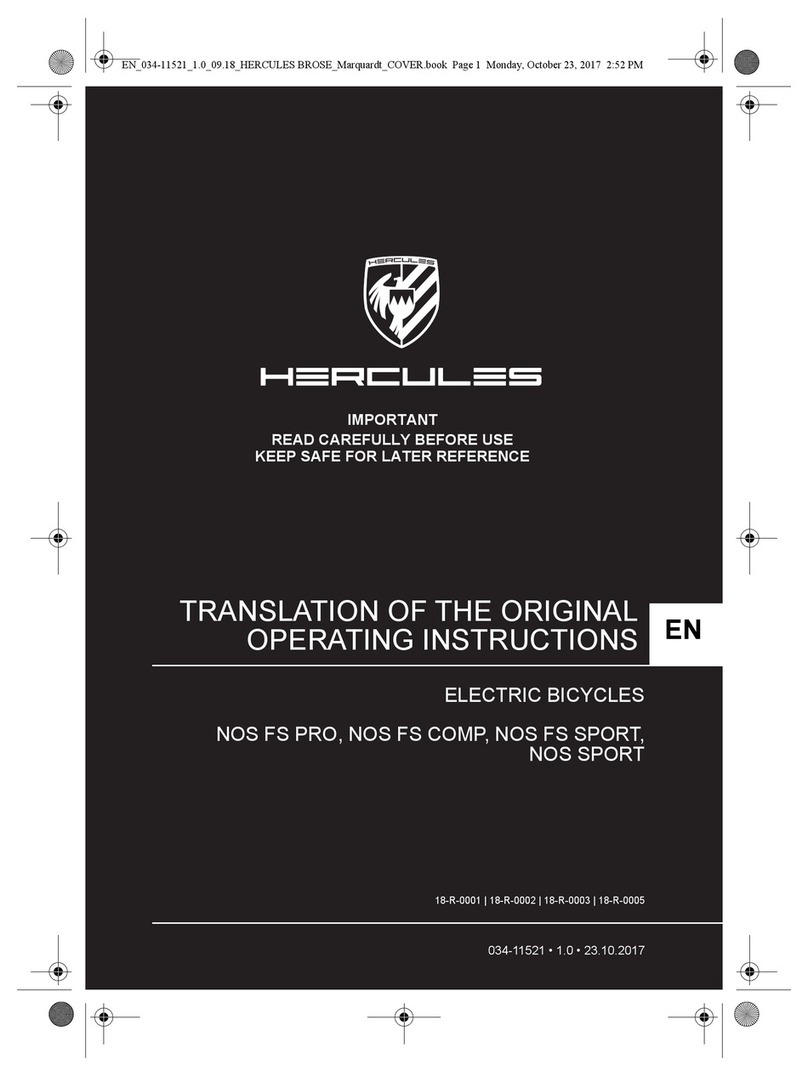
Hercules
Hercules NOS FS PRO Quick guide
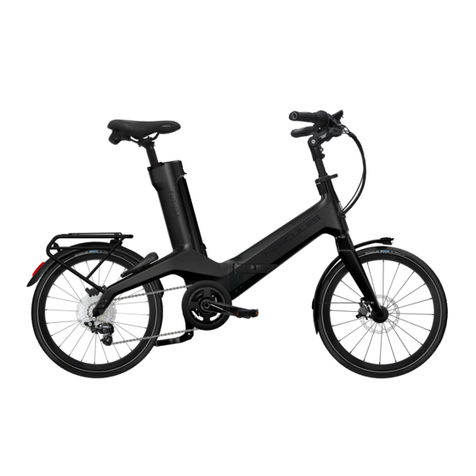
Hercules
Hercules Fazua Futura User manual
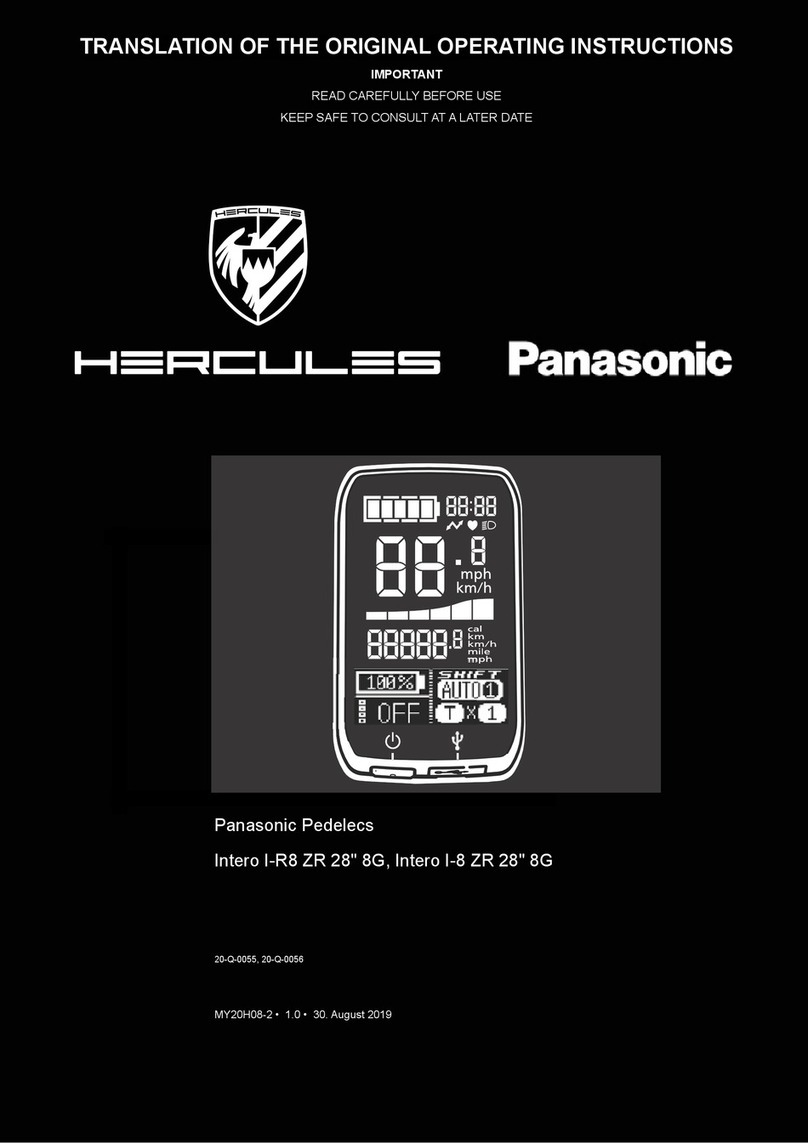
Hercules
Hercules Intero I-R8 ZR 28" 8G Series User manual
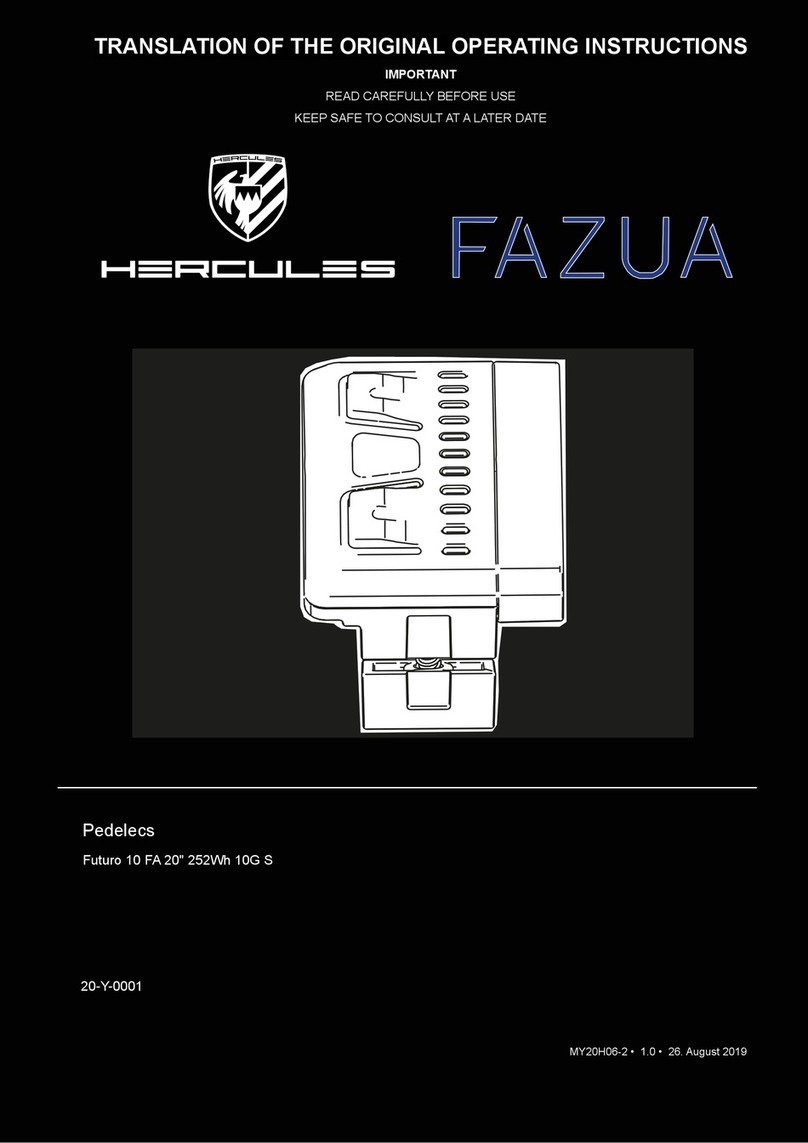
Hercules
Hercules FAZUA Futuro 10 FA 20" 252Wh 10G S Quick guide
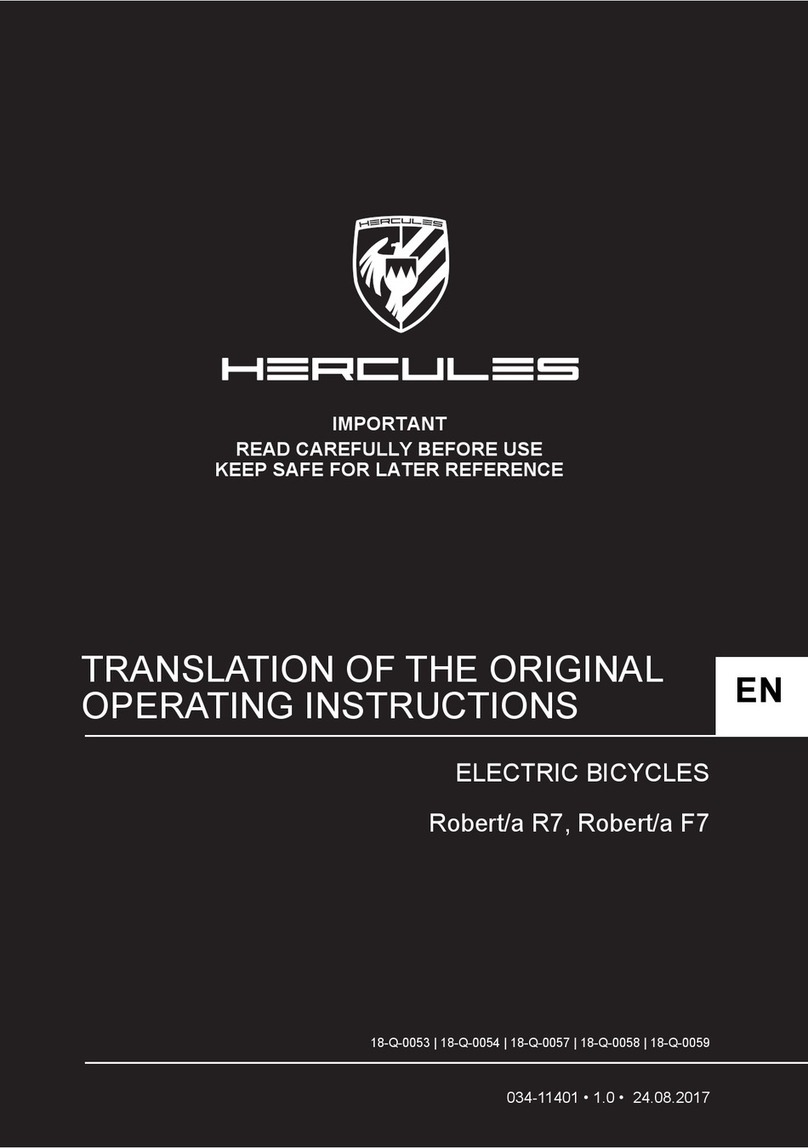
Hercules
Hercules Robert/a R7 Series User manual

Hercules
Hercules FUTURA SPORT 8.4 26 Quick guide

Hercules
Hercules Montfoort User manual

Hercules
Hercules Montfoort Cruise F7 User manual

Hercules
Hercules Tessano Pro User manual
